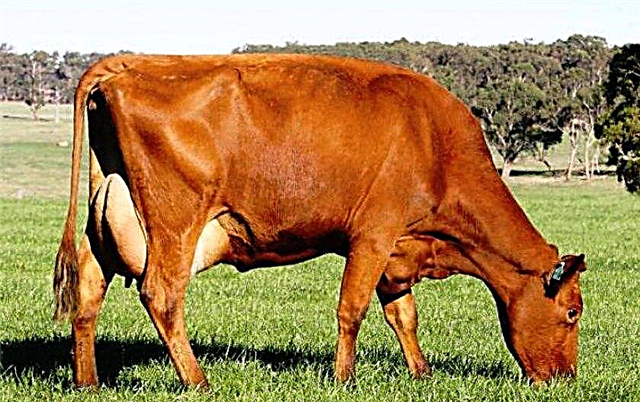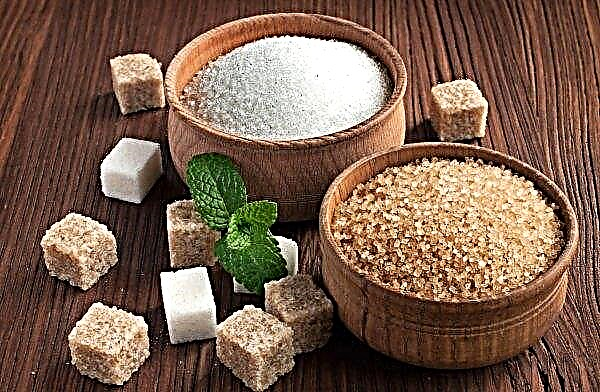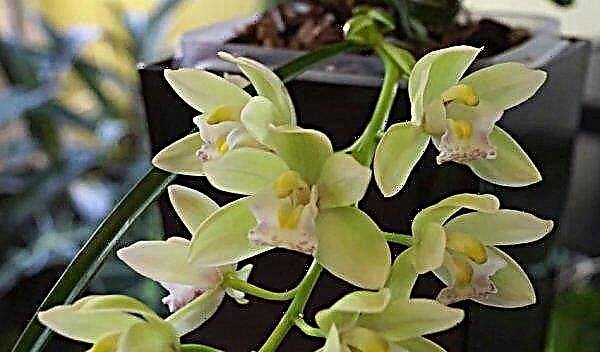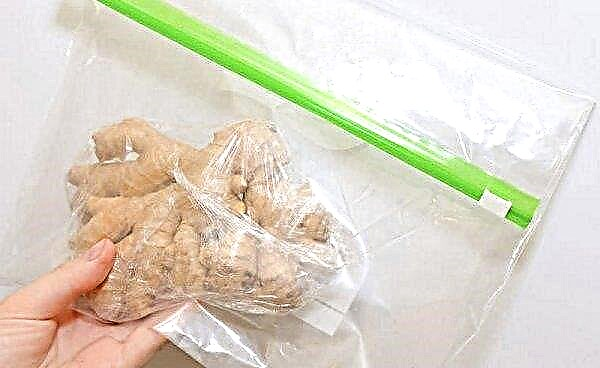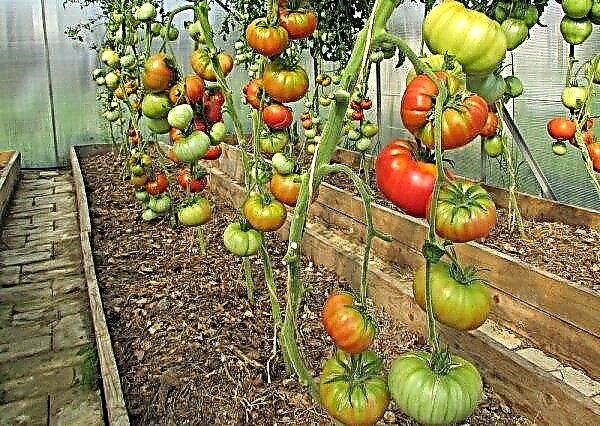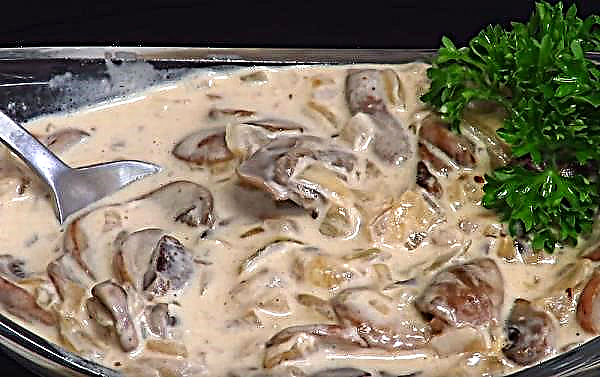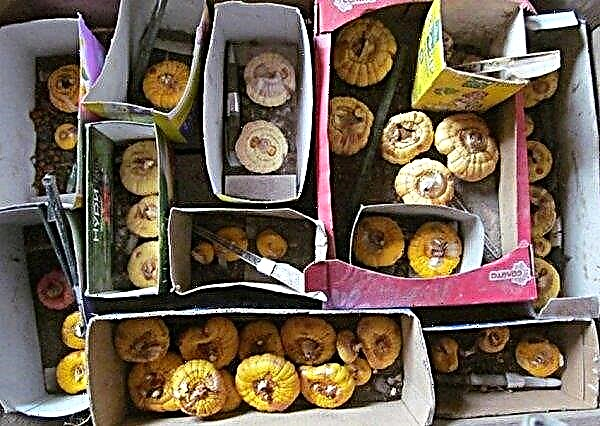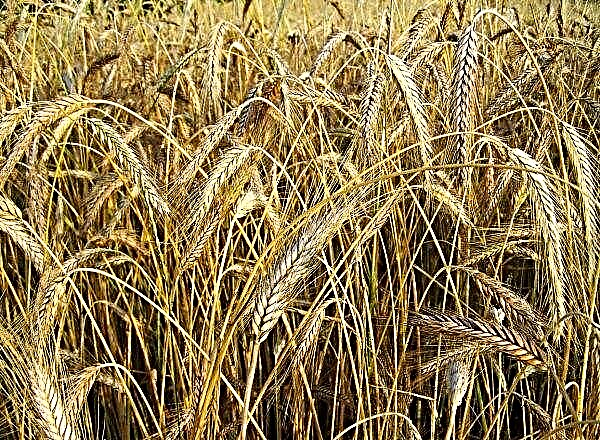In summer, it’s time for your favorite tomatoes. Sugar pudovichok can be perfectly eaten in its natural form or used as an ingredient for salads and cold appetizers. Features of the cultivation of this variety will be considered in the article.
Description and characteristics of the variety
Tomatoes Sugar pudovichok fleshy and very tasty. Ideal for making tomato pastes, juices, ketchups and sauces. For the winter, various canned snacks are prepared from them, lecho. The fruits are quite large, in shape resembling a ball, only slightly flattened, pink-red.
By juiciness are characterized as medium, with a fleshy, granular middle. The bush grows to 1.5 m if it is grown in a greenhouse. Directly in the garden, the height is slightly less - about 1 m. Fruits grow with tassels, 5-6 pieces on each branch. A plant usually has 5–6 branches. Productivity from one bush is from 30 to 35 pieces.

The trunk of the bush usually has two dense stems. Rhizome of small size, pivotal. The foliage is ordinary, with sharp tips, light and dark shades of green. The average crop weight is in the range of 6–8 kg. Scientists of the Siberian Garden Novosibirsk company selected the tomatoes of the Sugar Pudovich variety at the end of the 20th century and registered in 1999. The company’s activity is aimed at the cultivation of varieties of various plants that can grow and bear fruit in a cold Siberian climate.
Advantages and disadvantages of the variety
Like all cultivated plants, tomatoes of this variety are not without their advantages and disadvantages.
- Benefits:
- tolerate cold weather well;
- plants are not picky in care;
- high productivity;
- large fruits;
- great taste;
- great for transportation;
- universality of application, can be used raw and in the form of blanks.
Did you know? The cultivation of tomatoes began by the tribes of local Indians in South America about 8-9 thousand years ago.
- Disadvantages:
- the variety is semi-determinant, from which it follows that the bushes must be tied up;
- stepsons are formed that need to be cleaned;
- due to the fact that the tomatoes are quite large and heavy, branches can break under their weight;
- in case of improper watering, there may be problems;
- tomatoes are not suitable for whole pickling and pickling;
- weakly resistant to harmful insects and diseases.
Optimum timing for sowing varieties
The species belongs to mid-season crops. Suitable planting time is the end of March - the beginning of April. Sowing to obtain seedlings is necessary approximately two months from the planned planting in open soil. The time of complete ripening of tomatoes from the moment of seedling emergence depends on climatic weather conditions. Usually is 110 to 120 days.
The basic rules of growing
To get a rich harvest, you need to adhere to the rules and recommendations of specialists at all stages of the plant growth process. For a timely landing, you need to look into the long-term weather forecast and find out when the frost stops. Having made a countdown for 55-65 days from this date, you can almost accurately determine the day of sowing seedlings. If you plan to plant in greenhouse conditions, then you can plant the seeds earlier for 2-3 weeks.
Growing seedlings
Stage 1. Carrying out antiseptic treatment of seeds and soil.
Seeds bought in bags at points of sale do not need to be decontaminated. However, if these are seeds that you yourself have procured, then they need preliminary processing. They can be detected fungal, bacterial or viral infections.
To do this, you can make one of the proposed solutions that will kill the infection:
- A solution of potassium permanganate 1%, in a proportion of 1 g per 100 ml of water. In the prepared solution, put the seeds wrapped in gauze and leave for 15-20 minutes. It is necessary to note time, it is impossible to overexpose. If overexposed - seed germination may decrease.
- Soda 0.5% solution, in the ratio of 0.5 g of soda to 100 ml of water. Soak the seeds with the prepared solution for a day. Soda solution, in addition to antiseptic properties, also contributes to faster fruiting.
- The drug "Fitosporin." It is offered in liquid and loose form. A liquid preparation should be taken 1 drop and mixed with 100 ml of water. Using the powder, make a solution in the ratio of 0.5 teaspoon of powder to 100 ml of water. Soak the seeds for 1–2 hours.
 In the soil, as well as in the seeds, a different infection can live. Therefore, all the soil that is supposed to be used for planting must undergo processing.
In the soil, as well as in the seeds, a different infection can live. Therefore, all the soil that is supposed to be used for planting must undergo processing.There are several ways:
- Pour the earth onto a baking sheet and fry in the oven for 10-15 minutes at a temperature of +180 ... + 200 ° C.
- Hold in the microwave for 1-2 minutes at 850 watts.
- Processing with boiling water: for this, the soil should be placed in a container with holes and pour a small amount of boiling water.
- Pour steep potassium permanganate solution.
Important! The disinfected soil should be moistened and left to “stand” at room temperature for 10-12 days. During this time, the soil will be filled with beneficial organisms that will beneficially affect planted plants.
Stage 2. Sowing seedlings.
Pour moistened soil into the container, make grooves to a depth of about 1 cm, at a distance of 3-4 cm from each other. To spread the seeds approximately at a distance of 1-2 cm from each other: the greater the distance between the seeds, the more time the seedlings can not be planted. Sprinkle the sown seeds with earth.

From above it is necessary to cover with a film or glass to ensure a constant microclimate, the humidity in which should be 80–90%. It is best to put containers with sown seedlings near a radiator or heater. For successful germination, seeds need a temperature of +25 ... + 30 ° C. Every day you need to monitor the condition of the soil.
If the earth is dry, it needs to be moistened with a spray gun, and if excessive humidity is formed, you should drain the soil by opening the glass. When mold appears as a result of high humidity, you need to carefully remove the top layer, pour soil with a solution of potassium permanganate or use an antifungal drug for watering. It can be Fundazole or Fitosporin.
Depending on the temperature of the air surrounding the seedlings, the first seedlings after sowing will appear through:
- +25 ... + 28 ° C - 3-4 days;
- +20 ... + 25 ° C - 5-6 days;
- +10 ... + 12 ° C - 12-15 days.
Did you know? The Swedish naturalist Karl Linney, who gave the name to many plants, named the tomatoes Solanum lycopersicum, which means wolf peaches.
Stage 3. Proper care
Tomatoes love the light. Therefore, seedlings need to be put in the brightest place. If there is little natural light, additional lighting with fluorescent lamps is recommended. Shoots like a humid climate. Therefore, you need to teach seedlings to normal humidity gradually. Every day for small periods of time you can open the film or glass. The crops can be fully revealed only after 1-2 weeks.

Watering must be done carefully, under the stem itself. To do this, it is better to use a pipette or syringe without a needle. The soil should not be wet or dry. The higher the seedlings become, the more water it requires. It is necessary to water either in the morning or in the afternoon. To obtain healthy sprouts, plants need to be fed with special fertilizers 2-3 weeks after the appearance of the first shoots.
Stage 4. Transfer.
A pick (transplant) in a large container is carried out for the first time after the appearance of the first leaves. It is necessary to transplant plants carefully and be sure to do this so that a bunch of earth remains on the roots. The second time they are picked 2-3 weeks after the first in an even larger container of at least 0.5 liters.
Landing site preparation
Tomatoes need loose and fertile soil for rich fertility. It is necessary to cook it in the fall. Dig the soil, sprinkle it with ash - one glass per m². Ash deoxidizes the soil and acts as a mineral fertilizer. The next layer is sawdust, 3-5 cm thick, in order to make the earth lighter and more porous. All soil is well settled until spring.
In spring, feed the soil with potash and phosphate fertilizers. A mixture of chernozem and peat soil in a ratio of 1: 1 is suitable for tomatoes. A few days before planting, the soil must be treated with a solution of potassium permanganate.
Seedling Planting Technology
It is recommended to transplant tomato bushes into the ground no earlier than March 20–25. The day for this is better to choose not sunny, but cool, cloudy and calm.

Phase:
- First you need to make holes at a distance of about 40-60 cm from each other in the same row. Add a quarter of a compost bucket, 1 glass of wood ash to the hole, you can add fertilizer, and a few shovels of earth, then mix everything.
- Plant in the holes, while deepening the stem by 2-3 cm.
- In a watering can, you can dilute a fertilizer saturated with microorganisms for better fertility and water the planted seedlings with it.
- Fill the stem with earth so that there is a hole for watering.
- Pour abundantly with ordinary water from above and sprinkle with dry earth.
Tomato Care Features
Tomatoes, like any other plant, respond well to care. Consider the most necessary procedures, performing which you can get a rich crop of tomatoes.
Watering rates
In dry weather, tomatoes can be watered abundantly. In a normal climate, watering should be carried out every 1-2 days, provided that 6-7 liters of water will be poured into each hole.
With the appearance of the first reddening fruits, it is not necessary to water abundantly to avoid fruit wateriness. Water for irrigation of tomatoes is recommended not cold.Important! When the tomatoes go up, the irrigation rate can be increased.
Top dressing
Tomatoes need extra nutrition. Natural seedlings are used for seedlings. For example, a mixture of manure and grass is perfect. You can buy fertilizers based on guano, vermicompost, humic. By nourishing the seedlings with fertilizers, the dose should be reduced by half from the recommended amount for a certain remedy.
Pasynkovka and formation of a bush
Tomatoes need to be stepson. Stems cut off those that grow above the first branch. It is recommended after the formation of the ovary to pick off the leaves located below the first brush.

Soil cultivation and weeding
Before planting, be sure to dig and loosen the soil. Weeds around the bushes must be weeded.
Sugar pudovichok diseases and pests
Although the variety in question tolerates the harsh climate, it is not resistant to many diseases and pests. The most common enemies of this culture are phytophthora attack and tobacco mosaic infection. In greenhouse conditions, tomatoes often suffer from brown spotting. Of the insects that harm plants - these are caterpillars of garden scoops, spider mites, wireworms.
To avoid these troubles it is required:
- antiseptic treatment of seeds and soil;
- processing of bushes with special means aimed at protecting against diseases and pests.
Harvesting and storage
Harvesting tomatoes is necessary when the fruits have just begun to grow brown. In warmth, they ripen in a week, in taste they will not differ in any way from tomatoes picked from a bush.

Wooden crates are best for storing tomatoes. They need to be tightly packed dry, whole, healthy fruits. Put these boxes in a cool place, preferably non-residential and ventilated. Using this method, the tomatoes will be stored for 2 months. Thus, in order for the beds to please a rich harvest of tomatoes, one must adhere to the basic rules. Grow with pleasure and enjoy delicious fruits.

